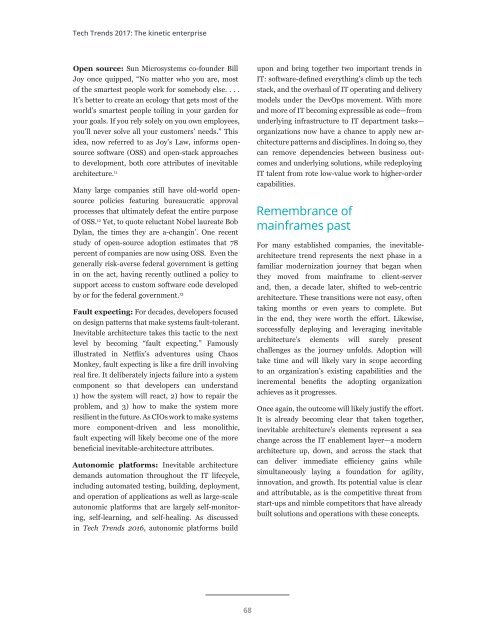Trending the trends Eight years of research
2kcf8xh
2kcf8xh
You also want an ePaper? Increase the reach of your titles
YUMPU automatically turns print PDFs into web optimized ePapers that Google loves.
Tech Trends 2017: The kinetic enterprise<br />
Open source: Sun Microsystems co-founder Bill<br />
Joy once quipped, “No matter who you are, most<br />
<strong>of</strong> <strong>the</strong> smartest people work for somebody else. . . .<br />
It’s better to create an ecology that gets most <strong>of</strong> <strong>the</strong><br />
world’s smartest people toiling in your garden for<br />
your goals. If you rely solely on you own employees,<br />
you’ll never solve all your customers’ needs.” This<br />
idea, now referred to as Joy’s Law, informs opensource<br />
s<strong>of</strong>tware (OSS) and open-stack approaches<br />
to development, both core attributes <strong>of</strong> inevitable<br />
architecture. 11<br />
Many large companies still have old-world opensource<br />
policies featuring bureaucratic approval<br />
processes that ultimately defeat <strong>the</strong> entire purpose<br />
<strong>of</strong> OSS. 12 Yet, to quote reluctant Nobel laureate Bob<br />
Dylan, <strong>the</strong> times <strong>the</strong>y are a-changin’. One recent<br />
study <strong>of</strong> open-source adoption estimates that 78<br />
percent <strong>of</strong> companies are now using OSS. Even <strong>the</strong><br />
generally risk-averse federal government is getting<br />
in on <strong>the</strong> act, having recently outlined a policy to<br />
support access to custom s<strong>of</strong>tware code developed<br />
by or for <strong>the</strong> federal government. 13<br />
Fault expecting: For decades, developers focused<br />
on design patterns that make systems fault-tolerant.<br />
Inevitable architecture takes this tactic to <strong>the</strong> next<br />
level by becoming “fault expecting.” Famously<br />
illustrated in Netflix’s adventures using Chaos<br />
Monkey, fault expecting is like a fire drill involving<br />
real fire. It deliberately injects failure into a system<br />
component so that developers can understand<br />
1) how <strong>the</strong> system will react, 2) how to repair <strong>the</strong><br />
problem, and 3) how to make <strong>the</strong> system more<br />
resilient in <strong>the</strong> future. As CIOs work to make systems<br />
more component-driven and less monolithic,<br />
fault expecting will likely become one <strong>of</strong> <strong>the</strong> more<br />
beneficial inevitable-architecture attributes.<br />
Autonomic platforms: Inevitable architecture<br />
demands automation throughout <strong>the</strong> IT lifecycle,<br />
including automated testing, building, deployment,<br />
and operation <strong>of</strong> applications as well as large-scale<br />
autonomic platforms that are largely self-monitoring,<br />
self-learning, and self-healing. As discussed<br />
in Tech Trends 2016, autonomic platforms build<br />
upon and bring toge<strong>the</strong>r two important <strong>trends</strong> in<br />
IT: s<strong>of</strong>tware-defined everything’s climb up <strong>the</strong> tech<br />
stack, and <strong>the</strong> overhaul <strong>of</strong> IT operating and delivery<br />
models under <strong>the</strong> DevOps movement. With more<br />
and more <strong>of</strong> IT becoming expressible as code—from<br />
underlying infrastructure to IT department tasks—<br />
organizations now have a chance to apply new architecture<br />
patterns and disciplines. In doing so, <strong>the</strong>y<br />
can remove dependencies between business outcomes<br />
and underlying solutions, while redeploying<br />
IT talent from rote low-value work to higher-order<br />
capabilities.<br />
Remembrance <strong>of</strong><br />
mainframes past<br />
For many established companies, <strong>the</strong> inevitablearchitecture<br />
trend represents <strong>the</strong> next phase in a<br />
familiar modernization journey that began when<br />
<strong>the</strong>y moved from mainframe to client-server<br />
and, <strong>the</strong>n, a decade later, shifted to web-centric<br />
architecture. These transitions were not easy, <strong>of</strong>ten<br />
taking months or even <strong>years</strong> to complete. But<br />
in <strong>the</strong> end, <strong>the</strong>y were worth <strong>the</strong> effort. Likewise,<br />
successfully deploying and leveraging inevitable<br />
architecture’s elements will surely present<br />
challenges as <strong>the</strong> journey unfolds. Adoption will<br />
take time and will likely vary in scope according<br />
to an organization’s existing capabilities and <strong>the</strong><br />
incremental benefits <strong>the</strong> adopting organization<br />
achieves as it progresses.<br />
Once again, <strong>the</strong> outcome will likely justify <strong>the</strong> effort.<br />
It is already becoming clear that taken toge<strong>the</strong>r,<br />
inevitable architecture’s elements represent a sea<br />
change across <strong>the</strong> IT enablement layer—a modern<br />
architecture up, down, and across <strong>the</strong> stack that<br />
can deliver immediate efficiency gains while<br />
simultaneously laying a foundation for agility,<br />
innovation, and growth. Its potential value is clear<br />
and attributable, as is <strong>the</strong> competitive threat from<br />
start-ups and nimble competitors that have already<br />
built solutions and operations with <strong>the</strong>se concepts.<br />
68


